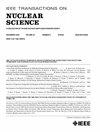Evaluating Proton Dose Modeling in Shielded Systems With On-Orbit LED Degradation
IF 1.9
3区 工程技术
Q3 ENGINEERING, ELECTRICAL & ELECTRONIC
引用次数: 0
Abstract
On-orbit output degradation of a light-emitting diode (LED) is used to compare displacement damage dose (DDD) calculation techniques, trapped proton environmental models, and increasing levels of shielding modeling fidelity to make conclusions on the margins inherent in dose modeling for light to heavily shielded systems. Good agreement with on-orbit degradation is found within a subset of the variety of these modeling techniques investigated. The fundamentals of the DDD calculations, both damage factors and their integration limits over varying energy ranges, are found to matter less than consideration of the secondary neutron contribution to the displacement damage in the more common heavily shielded systems uncovered with high-fidelity modeling codes. Historical minimum margins on top of trapped and solar radiation environmental models are confirmed to be outdated in comparison to the more recent use of confidence levels to address risk. Part-to-part and lot-to-lot part degradation variability is observed between the on-orbit data and identical modeling techniques. A quantitative evaluation of these modeling techniques and all the predicted data versus on-orbit data is presented.基于在轨LED退化的屏蔽系统中质子剂量建模的评估
使用发光二极管(LED)的在轨输出退化来比较位移损伤剂量(DDD)计算技术、捕获质子环境模型和不断提高的屏蔽建模保真度水平,从而得出轻到重屏蔽系统剂量建模固有的裕度结论。在所研究的各种建模技术的一个子集中发现了与在轨退化的良好一致性。研究发现,DDD计算的基本原理,即损伤因子及其在不同能量范围内的积分限制,在使用高保真建模代码揭示的更常见的重屏蔽系统中,次要中子对位移损伤的贡献比考虑次要中子更重要。与最近使用置信水平来处理风险相比,在被困和太阳辐射环境模型之上的历史最小边际已被证实是过时的。在轨道数据和相同的建模技术之间观察到部分到部分和批次到批次的退化变异性。对这些建模技术和所有预测数据与在轨数据进行了定量评价。
本文章由计算机程序翻译,如有差异,请以英文原文为准。
求助全文
约1分钟内获得全文
求助全文
来源期刊

IEEE Transactions on Nuclear Science
工程技术-工程:电子与电气
CiteScore
3.70
自引率
27.80%
发文量
314
审稿时长
6.2 months
期刊介绍:
The IEEE Transactions on Nuclear Science is a publication of the IEEE Nuclear and Plasma Sciences Society. It is viewed as the primary source of technical information in many of the areas it covers. As judged by JCR impact factor, TNS consistently ranks in the top five journals in the category of Nuclear Science & Technology. It has one of the higher immediacy indices, indicating that the information it publishes is viewed as timely, and has a relatively long citation half-life, indicating that the published information also is viewed as valuable for a number of years.
The IEEE Transactions on Nuclear Science is published bimonthly. Its scope includes all aspects of the theory and application of nuclear science and engineering. It focuses on instrumentation for the detection and measurement of ionizing radiation; particle accelerators and their controls; nuclear medicine and its application; effects of radiation on materials, components, and systems; reactor instrumentation and controls; and measurement of radiation in space.
 求助内容:
求助内容: 应助结果提醒方式:
应助结果提醒方式:


